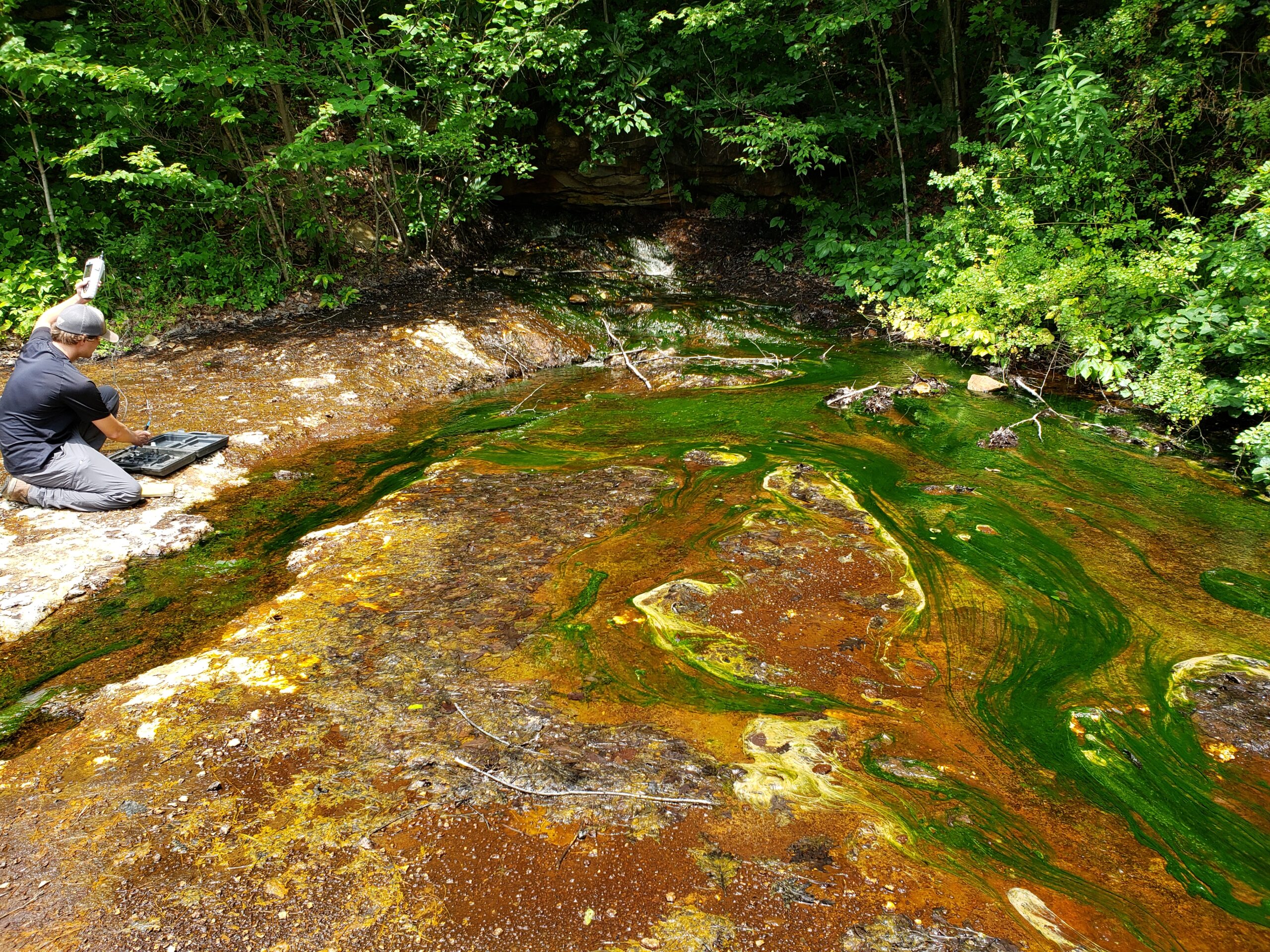MORGANTOWN — As Friends of the Cheat develop the Cheat River Rail-Trail next year, they hope to build a spur trail up to the site of the single largest contributor of acid mine drainage into the Cheat: the Lick Run Mine portals.
River users can see the effects of Lick Run’s acid mine drainage – AMD – where it meets the Cheat. A vast swath of the riverbank is stained orange from the iron. And while the acidic Lick Run water runs clear, the collision with the higher pH Cheat causes the metals to precipitate out, so you can see the orange of the iron and the white of the aluminum swirling out of the mouth.
The scene is different up at the portals: a ghastly green nightmare of muck and ooze and a metal mini-mountain called The Scab.

“We hope that the hiking trail will bring people up here so they start asking questions and start understanding,” said Friends of Cheat Executive Director Amanda Pitzer. “This is still happening everywhere, it just isn’t in your face. … I come here a lot and it’s still a shock.”
For comparison, The Dominion Post regualarly reports that the defunct Richard Mine is the single largest source of acid mine drainage into the Deckers Creek. Each year, that contaminated flow puts into the creek 140,000 pounds of iron and 59,000 pounds of aluminum.
The also-defunct Lick Run Mine is worse: 300,000 pounds of iron and 200,000 pounds of aluminum per year.

Cheat River Rail-Trail construction will be funded with a total $4.2 million of Abandoned Mine Lands program money. Treating Lick Run is a separate, expensive, problem down the road. Part of the AML money will allow FOC to partner with the state Department of Environmental Protection to examine the feasibility of treating the polluted waters in a specially-designed facility somewhere between the portals and the mouth.
Pitzer estimates it would cost about $4.5 million for the facility plus up to $250,000 per year to run it. FOC hopes the proposed spur to the portals will help people see the need to treat the water.
The current route to the five mine portals is up a gated gravel road. FOC bought the 4.5-acre area in 2005 through a tax sale.
Two of the portals emerge from a grassy hillside. This is a reclaimed area and giant pipes drain into limestone channels. To reach the others, in unreclaimed land, you follow the run uphill, crossing it at one point. The coated rocks in the bed are so slimy they’re hard to pick up.
The water is crystal clear but filamentous green algae, pretty much all that can live in the water, creates a green sci-fi effect. After crossing the run you mount The Scab, a wide hill that stands about 6 feet tall, composed of iron deposits built up over 60 to 70 years.

Pitzer said DEP didn’t want to disturb it and release more metal into the water, so it now serves as a kind of protection.
One of the three portals has buried itself under iron deposits. Icy cold water pours out. A deep bog of green brown muck that looks almost solid lies before the portals. The AMD prevents the fallen forest leaves from breaking down, Pitzer said.
Air colder than an air conditioner blows from one portal. It would be refreshing on a hot day except it smells like sulphur.
Garrett Richardson, FOC monitoring technician, takes readings here and there along the run from the mouth to the portals.
At the mouth, pH was 2.76, highly acidic. Upsteam the pH is good, 6.87.
At the mouth, conductivity is 1,768. “It’s full of metals,” Richardson said.
Conductivity estimates water’s ability to conduct electricity and gives a picture of the amount of dissolved solids in the water. Pure water doesn’t conduct electricity.
At the portals conductivity hits 3,000. “I’ve never seen one that high,” Richardson said. “Six hundred is bad.”
The location of treatment plant remains a question. Pitzer and DEP both said the valley is narrow which makes placement problematic. Pitzer said it might have to go down closer to the trailhead.

And disposal of the metlallic sludge removed from the water is another question, Pitzer said. Channeling it back into the might might eventually fill the mine pool and cause a dangerous blowout.
At Richard Mine, DEP said it’s contemplating storing the sludge in the portion of the mine pool below the portal or placing it in geotubes – giant, porous textile tubes that allow the water to be drained out so the filled tubes can be used for longwall backfilling or other purposes.
And if the plant was built, Pizter said, another problem would be paying for operation and maintenance. That would have to come from AML funds and AML is set to expire in 2021.
Legislation to reauthorize AML is currently stalled but Sens. Joe Manchin and Shelley Moore Capito and Rep. David McKinley all told The Dominion Post they’re working to make sure the reauthorization gets done.
Tweet David Beard@dbeardtdp Email dbeard@dominionpost.com




